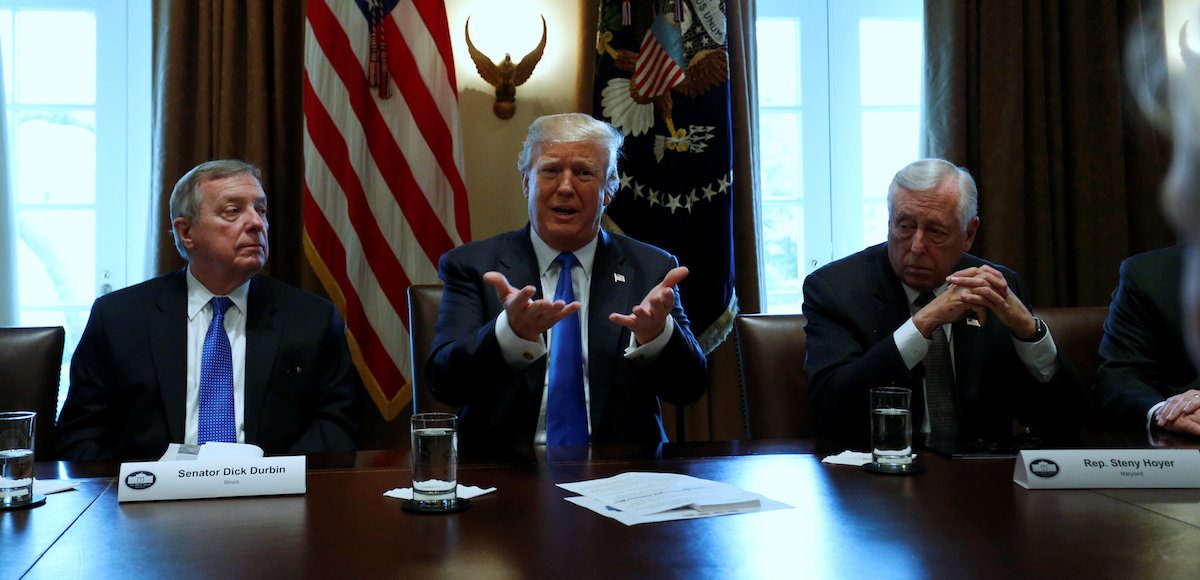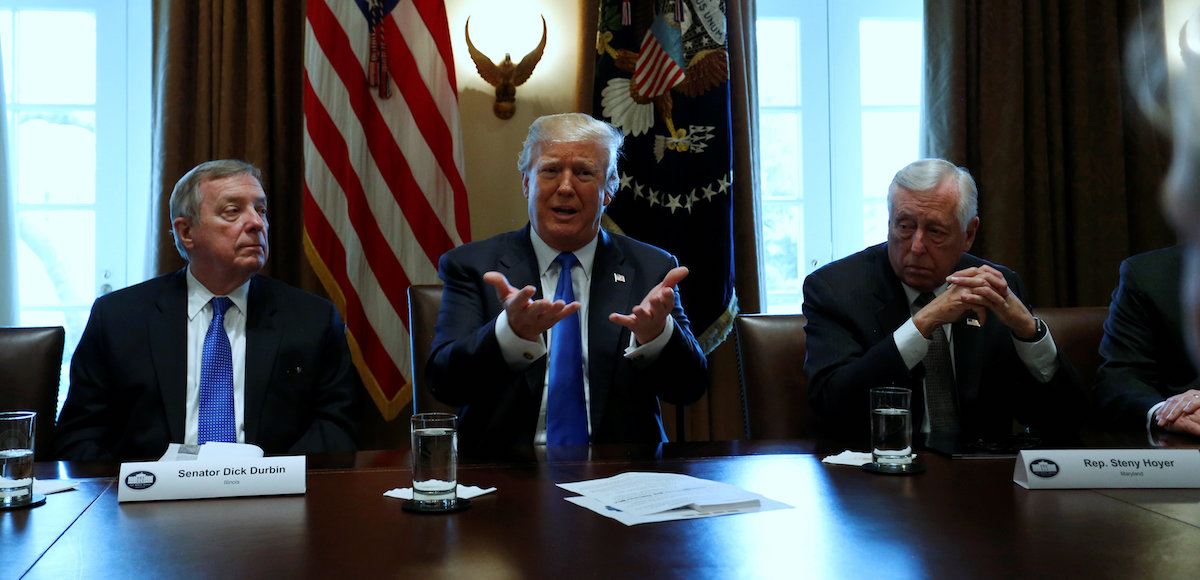

U.S. President Donald Trump, flanked by U.S. Senator Dick Durbin (D-IL) and Representative Steny Hoyer (D-MD), holds a bipartisan meeting with legislators on immigration reform at the White House in Washington, U.S. January 9, 2018. (Photo: Reuters)
President Donald Trump told lawmakers at the White House Tuesday they should consider bringing back “a concept of earmarks” with “better controls” because “our system lends itself to getting nothing done.” When voters gave Republicans the majority in Congress under the Obama Administration, they did away with earmarks, otherwise known as pork-barrel spending projects, to appease the conservative uprising within their party.
His remarks, which came during a bipartisan meeting on immigration reform, infuriated conservatives who elected a man on the promise to “drain the swamp.”
“If Republicans bring back earmarks, then it virtually guarantees that they will lose the House, stated Club for Growth President David McIntosh. “Bringing back earmarks is the antithesis of draining the swamp.”
House Rule XXI defines earmarks as “a provision or report language included primarily at the request of a Member, Delegate, Resident Commissioner, or Senator providing, authorizing or recommending a specific amount of discretionary budget authority, credit authority, or other spending authority for a contract, loan, loan guarantee, grant, loan authority, or other expenditure with or to an entity, or targeted to a specific State, locality or Congressional district, other than through a statutory or administrative formula driven or competitive award process.”
While it’s true that earmarks pale in comparison to other domestic spending programs, they’re generally used by lawmakers as what are essentially seen as bribes for supporting legislation.
Nevertheless, President Trump’s remarks weren’t off the cuff. They were meant to provide cover for House Speaker Paul Ryan, R-Wis., who twice-promised moderate, Big Government Republicans in the House a chance to reinstate them in late 2016 and again in 2017.
In mid-November 2016, Reps. Tom Rooney, R-Fla., and John Culberson, R-Texas, both introduced proposals to reinstate certain forms of earmarks on a limited basis. In what would’ve been one of the most tone-deaf disasters in the history of legislative politics, the House Republican Conference was literally moments away from voting on the Rooney-Culberson proposals before Speaker Ryan intervened.
The gavel-holder from Wisconsin spiked the effort, citing concerns they had just won a “drain the swamp” election. He made the argument that the optics would be a political nightmare. He convinced them to hold off on the effort to reinstate earmarks until later, after the New Year.
Hidden away from the public in the House Ways and Means Committee hearing room, which is located in the Longworth Office Building, the moderate caucus plotted how the 115th Congress could bring them back in January, 2017. According to multiple sources, they openly mocked the Trump platform and several of his “unrealistic” campaign promises, including the one to “build the wall” on the U.S. southern border with Mexico.
Ultimately, Speaker Ryan promised members a chance to reinstate earmarks in the first quarter of 2017, which didn’t come to fruition. Republicans were first consumed by multiple failed attempts to repeal ObamaCare, and later by a successful effort to overhaul the U.S. tax code for the first time in 31 years. But it came at a price.
Now, in return for their support on these and other issues (some earmarks proponents ended up voting “No” on the Tax Cuts and Jobs Act), Speaker Ryan is going to allow hearings on the issue. In return for his success at moving forward key pieces of the same agenda Republican lawmakers once mocked behind closed doors, President Trump is providing cover for Speaker Ryan on earmarks.
“Earmarks will only benefit the special interests that grow government at the expense of working men and women,” Mr. McIntosh added.
Read Also – Businessman Mike Braun, U.S. Senate Candidate in Indiana, Slams GOP for Reconsidering Earmarks







Col. Ben Bannister / January 10, 2018
Very interesting-
/
Betty Dekanchuk / January 11, 2018
No earmarks Ryan. You’ll probably be out in 2020.
/